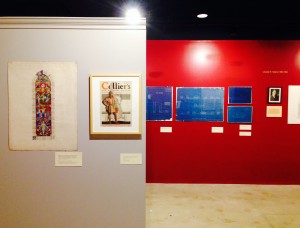
By Ally Byrne, Contributing Writer ||
A new art exhibition, “Building Memory: Architecture and the Great War,” opened Sept. 4 in the Gibson Curriculum Gallery of The Phillips Museum of Art. The exhibition chronicles the experiences that architects in Europe underwent during and after World War I (WWI), when they were charged with rebuilding destroyed cities and creating memorials to aid in the collective remembrance of the war.
The exhibit’s theme ties in with many other events that will take place throughout the year at F&M to commemorate WWI’s centenary. The exhibit features five architects, Paul P. Cret, Ralph Adams Cram, William Hough, Leicester Holland, and Richard Stillwell.
Many of these architects served in the army during WWI and dealt with the tragedy of the war firsthand, and “Building Memory” explores how their experiences shaped the architecture they later created and how they chose to rebuild after the war.
“Building Memory brings together these five architects and their collective experiences and explores how they shaped the commemoration of the war through the erection of the war monuments and the preservation of cultural heritage,” said Brittany Baksa, collections assistant at The Phillips Museum of Art. “The way the exhibit is organized is by architect. You will be viewing a little bit of history with a photo of the architect, and you will see some of their original works, whether it’s blueprints or architectural drawings.”
Baksa was integral in the process of borrowing art from other museums and institutions to be included in the exhibit, as well as organizing the pieces in the exhibition.
“Building Memory” is the vision of Kostis Kourelis, assistant professor of art history, who approached The Phillips Museum last year with the idea to curate this exhibition and design a first-year Connections course around the topic. Kourelis’ students will spend a lot of time in the exhibition and learn from first-hand contact with the art.
“This is intended to be the subject of our semester studies,” Kourelis said. “It shows the artistic side of how various architects commemorated the war. Freshman will get their first introduction on how to read a visual picture.”
Baksa also described the process of curating the exhibition from start to finish.
“The museum receives an exhibition proposal [from an outside source] which is then reviewed by the museum staff,” Baksa said. “Then it is submitted to the exhibition committee, and, through that, the artists and the curators collaboratively work on a process to develop a comprehensive exhibition.”
“Building Memory” is also connected with another exhibition focusing on World War I, “Before Rosie the Riveter: Women and Work in World War I,” which documents women’s responses to the war. This exhibition opened Sep. 4 in the Rothman Gallery and focuses on the massive propaganda effort throughout the U.S. that brought women together during the war and encouraged them to join the workforce.
Baska is hoping “Building Memory” will spark a general interest in architecture and how architecture and memorials affect how traumatic events are collectively remembered and reveal each architects’ different thought process and planning processes.
Kourelis also hopes the exhibition will convey to a broader audience the ways in which each architect was affected by the war, whether by watching their friends fight or fighting in it themselves. Instead of focusing on the violence of the war or its destruction, “Building Memory” explores how the architects responded to the war and helped to rebuild and memorialize those affected.
“More importantly, when the war was over, how did the artists use their skills to actually commemorate the war, this horrific experience?” Kourelis said.
The exhibition is divided into five sections, with one section for each different architects’ work. Within the works, there is a division between architects whose style was more classical and those who worked with the gothic style.
“The bottom line is that the classic exhibit wants to show people that there are these two vocabularies: the classical, the ancient, and then the Christian, the medieval, the gothic, the crafted,” Kourelis said. “These two are the two mediums that are used to talk about death and war.”
First-year Ally Byrne is a contributing writer. Her email is abyrne@fandm.edu.